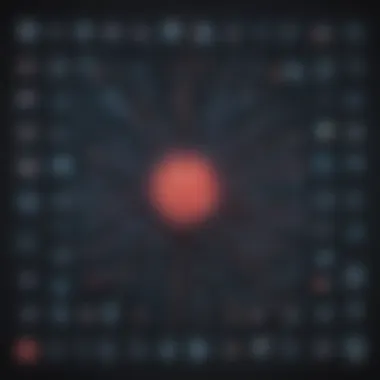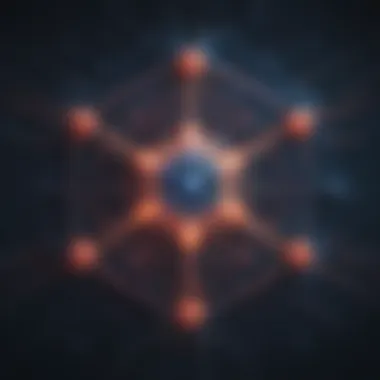Unveiling the Complexities of Convolutional Neural Networks: An In-Depth Exposition


Tech Trend Analysis
Convolutional Neural Networks (CNNs) have emerged as a prominent trend in the tech sphere. As artificial intelligence advances, CNNs play a crucial role in image recognition, natural language processing, and other domains. Their efficacy in pattern recognition and classification tasks has captivated tech enthusiasts worldwide. The implications of CNNs for consumers are vast, ranging from personalized recommendations in online shopping to enhanced medical diagnostics. Looking ahead, the future predicts increased integration of CNNs in smart devices, autonomous systems, and innovative applications.
Product Reviews
When delving into the realm of CNNs, an overview reveals their intricate architecture and algorithms. CNNs boast features like convolutional layers, pooling layers, and fully connected layers that enable deep learning. With specifications catering to complex data processing and feature extraction, these networks showcase impressive performance in image and voice recognition tasks. While the pros include high accuracy and efficiency, cons may entail resource-intensive training and potential overfitting. Overall, endorsing CNNs for developers and researchers seeking robust solutions in artificial intelligence projects is highly recommended.
How-To Guides
Understanding CNNs necessitates an introductory overview encompassing their inception and development. Progressing further requires step-by-step instructions on setting up a CNN model, training it with appropriate datasets, and fine-tuning its parameters for optimal performance. Proffering tips and tricks to streamline the model optimization process enhances the learning curve for enthusiasts venturing into CNN implementation. Furthermore, troubleshooting common issues like vanishing gradients or overfitting ensures a comprehensive understanding of CNN intricacies.
Industry Updates
Recent strides in the tech industry have witnessed remarkable advancements in CNN applications. Analyses of market trends reveal a shift towards AI-driven solutions and smart technologies fueled by CNN capabilities. The impact on businesses includes enhanced productivity through automated processes and personalized customer experiences. Consumers benefit from tailored services and cutting-edge products empowered by CNN innovations, paving the way for a tech-savvy future.
Introduction to Convolutional Neural Networks
In this article, we embark on a journey to unravel the complexities of convolutional neural networks (CNNs), integral to the realms of artificial intelligence and machine learning. Understanding CNNs is paramount for tech enthusiasts and industry professionals navigating the landscape of cutting-edge technology. This section serves as a foundational pillar, setting the stage for a deep dive into the core principles and intricate mechanisms that underpin CNNs.
Defining Convolutional Neural Networks
Origin and Evolution of CNNs
Delving into the origin and evolution of CNNs illuminates the rich history that underscores these neural networks' development. The journey from their inception to present-day sophistication showcases the relentless pursuit of enhancing algorithmic capabilities in image processing and pattern recognition. The unparalleled ability of CNNs to learn hierarchical representations from data has revolutionized various industries, making them a go-to choice for a myriad of applications in today's technological landscape. Despite their remarkable advantages, challenges such as overfitting and complexity continue to be areas of exploration and improvement in CNN research, underscoring the dynamic evolution of these networks.
Key Components of CNNs
The key components of CNNs form the structural foundation driving their functionality and efficacy. Elements like convolutional layers, pooling layers, and fully connected layers work in unison to process and extract features from input data efficiently. Each component plays a pivotal role in enhancing the network's ability to learn intricate patterns and relationships within complex datasets. While CNNs offer unparalleled advantages in tasks like image recognition and classification, they are not devoid of limitations, with issues like computational intensity and data dependency posing as challenges. Understanding the nuances of these key components is essential for harnessing the true potential of CNNs in real-world applications.
Applications of Convolutional Neural Networks
Image Recognition and Classification
Image recognition and classification stand as cornerstones in the application of CNNs, showcasing their prowess in tasks requiring visual understanding and categorization. The adeptness of CNNs in identifying objects, patterns, and features within images has found immense utility in diverse domains, from autonomous vehicles to healthcare diagnostics. Leveraging the power of deep learning, CNNs have set new benchmarks in accuracy and efficiency, making them indispensable tools for industries reliant on image analysis.
Object Detection and Localization


The realm of object detection and localization benefits significantly from the robust capabilities of CNNs, offering precision and speed in identifying and pinpointing objects within images or videos. The ability to detect objects with high accuracy and localize their positions accurately has empowered applications spanning surveillance, augmented reality, and autonomous systems. However, challenges related to handling scale variance and occlusions necessitate ongoing advancements in CNN methodologies for optimal performance.
Medical Image Analysis
In the domain of medical imaging, CNNs play a transformative role in automating tasks such as disease diagnosis, tissue segmentation, and anomaly detection. Their proficiency in deciphering intricate details within medical images not only expedites diagnostic processes but also enhances the accuracy of outcomes. Despite the strides made in utilizing CNNs for medical image analysis, considerations around data privacy and interpretability remain focal points for further exploration and refinement.
Natural Language Processing (NLP)
Natural Language Processing (NLP) applications integrate CNNs to democratize text analysis, sentiment classification, and language modeling. The fusion of NLP with CNNs offers a robust framework for deciphering textual data, enabling tasks like sentiment analysis and text classification with efficiency and precision. While the synergy between CNNs and NLP heralds new possibilities in language processing, challenges related to model interpretability and bias mitigation underscore the need for continuous innovation and ethical considerations in AI applications.
Architecture and Mechanisms of Convolutional Neural Networks
Understanding the Architecture and Mechanisms of Convolutional Neural Networks is crucial in unraveling the intricate layers of artificial intelligence. This segment delves deep into the core structure and operational mechanisms of CNNs, shedding light on their significance in driving machine learning advancements. Exploring the layers and mechanisms provides a comprehensive insight into how CNNs process data and extract valuable features for complex tasks.
Layers in a Convolutional Neural Network
Convolutional Layer
The Convolutional Layer plays a pivotal role in CNNs, as it processes input data through convolutional operations. This layer is fundamental in detecting patterns and features within the input data, enhancing the network's ability to recognize complex objects and structures. Its unique characteristic lies in its ability to extract spatial hierarchies from the input, making it a popular choice for image recognition tasks. While the Convolutional Layer offers exceptional feature extraction capabilities, it may face challenges with maintaining spatial information and model interpretability.
Pooling Layer
The Pooling Layer contributes significantly to downsizing the spatial dimensions of the network's input. By reducing the complexity of the extracted features, this layer aids in controlling overfitting and improving computational efficiency. Its key characteristic involves aggregating feature maps to preserve essential information while reducing computational workload. The Pooling Layer's unique feature lies in its ability to enhance the network's translation invariance, making it a beneficial choice for tasks requiring robust feature detection. However, excessive pooling may lead to information loss and subsequent reduction in model accuracy.
Fully Connected Layer
The Fully Connected Layer plays a vital role in integrating the features extracted by previous layers for final classification or regression. By connecting all neurons in the previous layer to every neuron in the following layer, it enables comprehensive feature representation and decision-making. Its key characteristic involves processing the extracted features to generate final output predictions, making it a popular choice for tasks requiring high-level feature abstraction. The Fully Connected Layer's unique feature lies in its ability to capture complex relationships within the data, enhancing the network's predictive capabilities. However, the increased connectivity may lead to overfitting and higher computational requirements.
Activation Functions and Regularization Techniques
ReLU Activation Function
The Rectified Linear Unit (Re LU) Activation Function revolutionized deep learning by introducing non-linearity and sparsity to the networks. Its key characteristic involves activating neurons only if the input is greater than zero, accelerating the learning process and improving model convergence. The unique feature of ReLU lies in its simplicity and computational efficiency, making it a preferred choice for accelerating gradient-based optimization. However, ReLU may suffer from issues like dead neurons and non-zero mean inputs, affecting model performance in complex tasks.
Dropout Regularization
Dropout Regularization acts as a potent tool in combating overfitting by randomly deactivating a fraction of neurons during training. This technique enhances model generalization by promoting robust feature learning and reducing interdependence among neurons. The key characteristic of Dropout lies in its ability to improve model resilience to noise and variations in input data, enhancing the network's performance on unseen examples. Its unique feature lies in its simplicity and effectiveness in preventing overfitting without requiring significant computational resources. However, excessive dropout rates may hinder learning capacity and slow convergence.


Training a Convolutional Neural Network
Backpropagation
Backpropagation serves as the backbone of CNN training, facilitating error propagation and weight updates across the network. Its key characteristic involves iteratively adjusting network weights based on gradient information, optimizing model performance through efficient error minimization. The unique feature of Backpropagation lies in its ability to fine-tune network parameters and improve prediction accuracy, vital for learning complex patterns from data. Despite its effectiveness, backpropagation may face challenges with vanishing gradients and computational intensity, impacting training efficiency in deep networks.
Gradient Descent
Gradient Descent optimizes CNN training by iteratively updating network parameters to minimize the loss function. Its key characteristic involves calculating gradients to determine the direction of weight adjustments, facilitating convergence towards the global optima. The unique feature of Gradient Descent lies in its adaptability to various network architectures and optimization objectives, making it a versatile choice for model training. However, issues like slow convergence and susceptibility to local minima may impact its effectiveness in complex optimization landscapes.
This detailed exploration of Architecture, Layers, Activation Functions, Regularization Techniques, and Training in Convolutional Neural Networks equips tech enthusiasts and industry professionals with a profound understanding of CNN operational mechanisms, fostering insightful interpretations and informed decision-making in AI applications.
Advanced Concepts in Convolutional Neural Networks
In the realm of convolutional neural networks, understanding advanced concepts plays a crucial role in grasping the intricacies of this artificial intelligence domain. This segment delves into sophisticated mechanisms that go beyond the basics, offering a deeper insight into how CNNs operate. By exploring advanced concepts, readers can unravel the complexities of CNN models and their applications in diverse fields. From transfer learning to object detection, these concepts pave the way for innovation and optimization in AI algorithms, making them invaluable in the tech landscape.
Transfer Learning and Fine-Tuning
Utilizing Pretrained Models
When it comes to leveraging pretrained models in convolutional neural networks, the advantages are significant. Utilizing pretrained models allows for the transfer of knowledge from one task to another, enabling quicker model training and improved performance on new datasets. This approach reduces the need for extensive data collection and computational resources, making it a popular choice among practitioners aiming for efficiency and robustness in their AI applications. While utilizing pretrained models may offer time and resource-saving benefits, there are considerations regarding domain adaptation and feature relevance that need to be addressed to ensure optimal performance in specific contexts.
Adapting Models to New Datasets
Adapting models to new datasets is a critical aspect of staying relevant and effective in the ever-evolving landscape of convolutional neural networks. By fine-tuning models on fresh data, AI practitioners can enhance model accuracy and generalization, catering to specific objectives or target domains. This adaptation process involves adjusting model parameters and architecture to suit the characteristics of the new dataset, establishing a custom-fit approach that boosts performance and ensures applicability in real-world scenarios. While adapting models to new datasets fosters flexibility and customization, challenges such as domain shift and overfitting need to be carefully managed to maintain model robustness and reliability.
Object Detection using CNNs
Region Proposal Networks
One of the key components in object detection using convolutional neural networks is the integration of region proposal networks (RPNs). These networks are designed to generate candidate object regions with the potential to contain objects of interest, serving as a precursor to the final detection process. By efficiently proposing region hypotheses, RPNs streamline the object localization task, optimizing detection accuracy and speed. The ability of RPNs to prioritize relevant regions for further analysis contributes significantly to the overall performance of object detection systems, making them an indispensable tool in extracting meaningful spatial information from images.
Anchor Boxes
Anchor boxes provide a strategic framework for addressing scale and aspect ratio variations during object detection tasks in CNNs. By incorporating predefined anchor boxes at different positions and scales within an image grid, AI models can effectively capture object variations and spatial relationships, facilitating accurate localization and classification of objects. The use of anchor boxes enhances the model's ability to handle complex scenes and diverse object shapes, enabling robust performance across a wide range of detection scenarios. Despite their benefits in improving detection precision and recall rates, the selection and optimization of anchor box parameters require meticulous tuning to ensure optimal results in object detection applications.
Challenges and Future Trends


Overfitting in CNNs
The phenomenon of overfitting poses a significant challenge in training convolutional neural networks, where models learn to memorize training data rather than generalize to new samples. Overfitting can lead to reduced model performance on unseen data, compromising the reliability and applicability of CNN systems in practical settings. Mitigating overfitting involves employing regularization techniques, such as dropout and weight decay, to prevent the neural network from excessively fitting to noisy or irrelevant patterns in the training data. By addressing overfitting, AI researchers can enhance model generalization and robustness, paving the way for more reliable and accurate CNN applications.
Interpretability of AI Models
The interpretability of AI models remains a pivotal area of research and development in the convolutional neural network domain, aiming to elucidate how neural networks make decisions and predictions. Enhancing model interpretability enables stakeholders to understand the rationale behind AI-generated outputs, promoting trust, transparency, and accountability in algorithmic decision-making processes. Various techniques, including saliency maps and model-specific interpretability metrics, are being explored to shed light on the black-box nature of deep learning models, empowering users to interpret and validate AI predictions effectively. By prioritizing interpretability, CNN researchers can foster understanding and confidence in AI technologies, driving ethical and responsible deployment of intelligent systems.
Advancements in CNN Research
The continuous advancement of research in convolutional neural networks fuels innovation and breakthroughs in AI capabilities, driving progress in diverse domains from healthcare to autonomous systems. Cutting-edge studies focus on improving model efficiency, interpretability, and generalization, pushing the boundaries of CNN performance and scalability. By integrating novel architectures, optimization algorithms, and training strategies, researchers aim to overcome existing limitations and explore new frontiers in deep learning research. These advancements not only enrich the CNN landscape but also shape the future of artificial intelligence, offering unprecedented opportunities for transformative solutions and applications across industries.
Real-World Applications of Convolutional Neural Networks
In this segment of our detailed exploration of Convolutional Neural Networks (CNNs), we shift our focus towards the practical implications and significance of integrating this technology into real-world scenarios. Understanding the real-world applications of CNNs is crucial for grasping their transformative potential in various industries. By shedding light on how CNNs are utilized beyond theoretical frameworks, we aim to provide insight into the tangible benefits and challenges associated with their implementation.
Autonomous Vehicles and CNNs
Object Detection in Self-Driving Cars
Delving into the fusion of Autonomous Vehicles and CNNs, the domain of Object Detection in Self-Driving Cars stands out as a critical component. This specialized application revolves around the ability of CNNs to discern and categorize objects in the vehicle's surroundings, thereby ensuring safe navigation and decision-making processes. The key allure of Object Detection in Self-Driving Cars lies in its prowess to accurately identify pedestrians, vehicles, road signs, and obstacles in real-time. This capability is pivotal for autonomous vehicles to react promptly to dynamic environments, enhancing both passenger safety and operational efficiency. Despite its advantages in bolstering road safety, challenges such as occlusions and varying environmental conditions pose complexities that necessitate ongoing enhancements in CNN algorithms.
Lane Detection Algorithms
Within the realm of Autonomous Vehicles, Lane Detection Algorithms epitomize a fundamental application empowered by CNNs. Facilitating the recognition and tracking of lane markings on road surfaces, these algorithms play a fundamental role in autonomous navigation and lateral control. The intrinsic versatility of Lane Detection Algorithms lies in their adaptability to diverse road geometries and environmental factors, enabling vehicles to maintain trajectory alignment and prevent lane departure incidents. While these algorithms significantly elevate the autonomous driving experience, issues such as poor lane visibility and edge cases present continual areas for refinement and optimization.
Healthcare and Medical Imaging
Early Disease Diagnosis
Transitioning into the healthcare sector, the integration of CNNs for Early Disease Diagnosis has revolutionized diagnostic practices. By harnessing the power of CNNs in analyzing medical imaging data, healthcare professionals can expedite the identification of potential diseases at their nascent stages. The advent of Early Disease Diagnosis through CNNs not only expedites treatment initiation but also enhances patient outcomes by fostering early intervention strategies. Despite its revolutionary impact, challenges related to data privacy and interpretability underscore the ongoing dialogue surrounding the responsible uptake of AI technologies in healthcare.
Medical Image Analysis
In parallel, Medical Image Analysis represents a sophisticated application domain empowered by CNNs in healthcare settings. By leveraging CNNs to interpret intricate details within medical images, practitioners can glean valuable insights for diagnosing conditions, planning treatments, and monitoring patient progress. The inherent accuracy and efficiency of Medical Image Analysis through CNNs amplify diagnostic capabilities and streamline clinical workflows. Nevertheless, considerations surrounding the standardization of imaging protocols and the integration of AI-driven solutions inherently shape the discourse on optimizing CNNs for medical imaging contexts.
Natural Language Processing (NLP) Applications
Sentiment Analysis
Shifting gears to the NLP paradigm, Sentiment Analysis emerges as a pertinent application area influenced by CNNs. Traversing the landscape of textual data, Sentiment Analysis harnesses CNNs to discern and categorize sentiments expressed within linguistic content. This capability finds widespread utility in social media analytics, customer feedback evaluation, and market trend forecasting. The essence of Sentiment Analysis lies in its capacity to extract nuanced emotional cues from textual data, offering valuable insights for strategic decision-making and brand sentiment monitoring. Despite its utility, challenges related to contextual ambiguity and domain-specific nuances underscore the nuanced landscape of Sentiment Analysis through CNNs.
Text Classification
Concluding our discourse on NLP applications, Text Classification emerges as a pivotal arena intrinsically linked to CNN-driven frameworks. By classifying textual data into predefined categories or labels, Text Classification underpins information organization, retrieval, and content structuring processes. The instrumental role of CNNs in Text Classification lies in their ability to identify patterns, features, and contextual cues within textual inputs, enabling accurate categorization and content clustering. While Text Classification optimizes information management paradigms, challenges such as data heterogeneity and evolving language models underpin the iterative evolution of CNN-based text classification methodologies.



